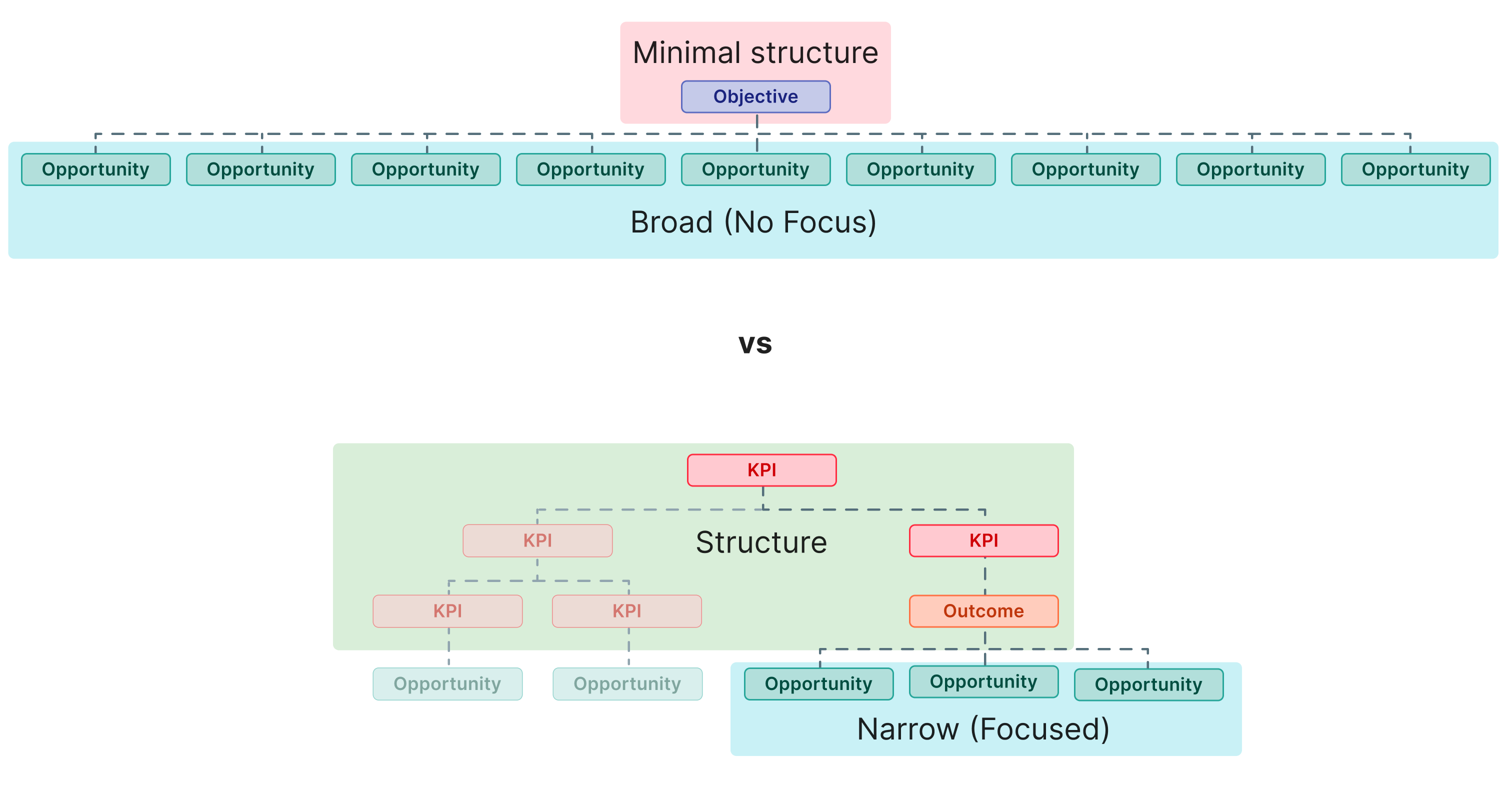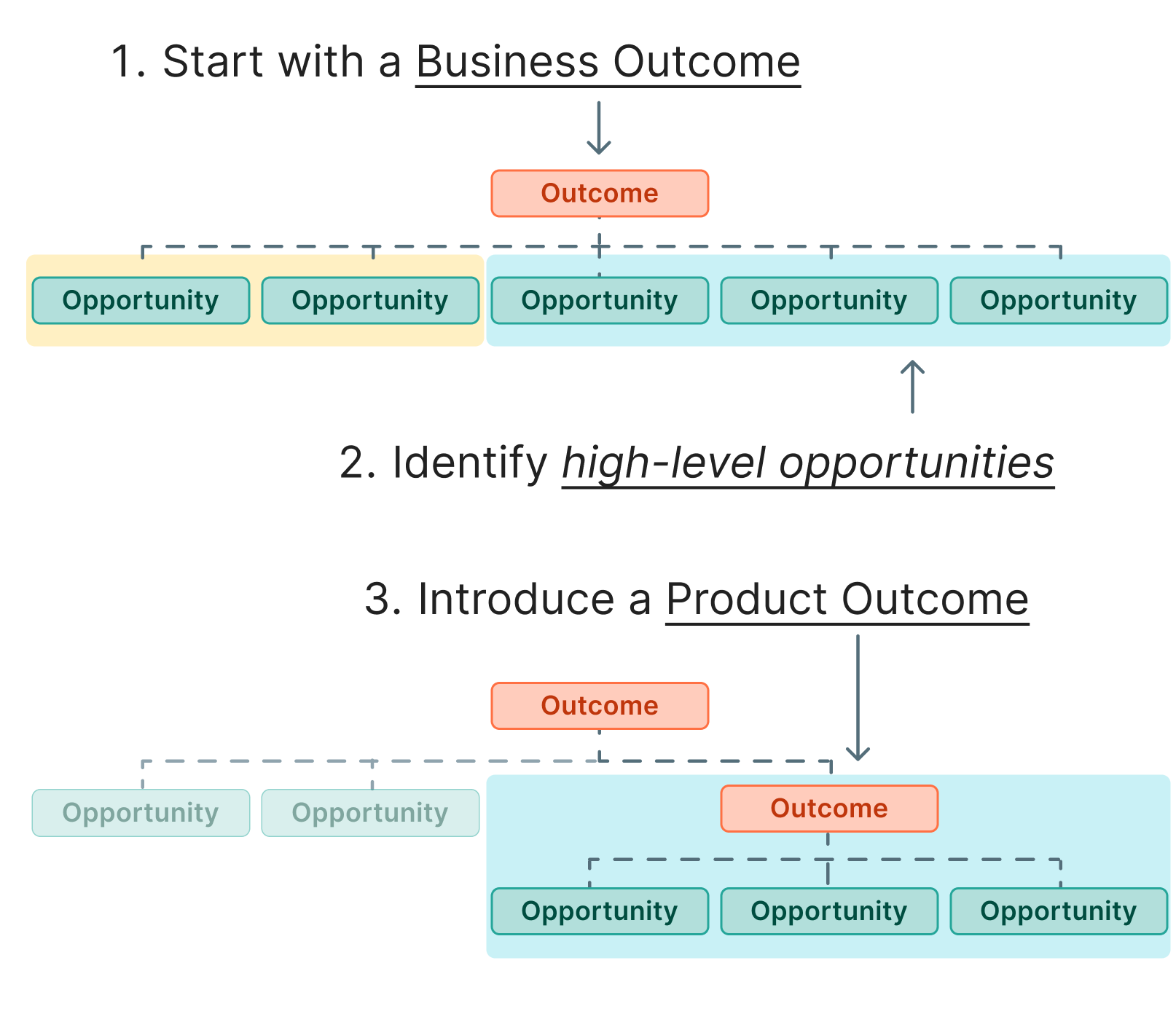- Part One (this post): Deep dive into five Mapper Archetypes. Each one showcases different ways we’ve observed individuals, trios, and entire teams become overwhelmed by their trees.
- Part Two: Interview with Dr. Else van der Berg (product management, discovery & validation enthusiast) on tactics she uses within her trios to keep noise down and signal high.
The Wandering Mapper
The Wandering Mapper sees the value in mapping the opportunity space but doesn’t have a clear outcome to anchor it. With no outcome at the top of an OST, opportunities will surface everywhere, but you will drift and lose focus and direction. The result is a broad smattering of opportunities that are difficult to prioritize.
- How do we acquire customers?
- How do we engage them?
- How do we convert them?
- How do we retain them?
- What’s our monetization strategy?

The Over-Mapper
The opportunity space cannot be fully mapped—it’s always evolving! The over-mapper tries to map the entire opportunity space, adding every opportunity, sub-opportunity, and sometimes every solution! Every opportunity does not need to be identified and addressed to achieve an outcome. The objective of mapping the opportunity space is to make sense of your best options, find the quickest path to success, and move on. Mapping every opportunity is similar to addressing every item in a backlog. It’s just not going to happen. You shouldn’t keep all discovered opportunities in your tree! The Fix Embrace the 80/20 rule (Pareto Principle). As you identify opportunities, which ones are in the top 20%? Focusing on the top 20% will often get you most of the way to your goal. That means investing more in fewer opportunities and ignoring the others – for now.

The Indecisive Mapper
The indecisive mapper starts with a large lagging business outcome, which is not bad in and of itself (sometimes, you don’t know what you don’t know). The indecisiveness comes into play when too much time has passed without niching down and focusing on a more specific outcome. Sometimes, it takes time to learn what will influence a lagging metric. Failing to narrow focus will result in the same problems The Wandering Mapper will face (going too broad with a lack of focus). The Fix Timebox the decision. Estimate how long it will take to go wide and learn enough to build conviction. Then, evaluate and decide. We’ve written on this pattern and have been calling it Backfilling Learning Goals.
- More work prioritizing longer lists of opportunities.
- More work conducting discovery on areas of the business that shouldn’t be a priority.
The Assumptive Mapper
The assumptive mapper adds opportunities to the tree based on their experience rather than real customer needs and pain points. Sometimes, they’re right, and often they’re off. It never ceases to amaze me how often hearing from customers alters my understanding of the opportunity space. Assumptive Mappers also miss out on one massive benefit. They end up misgauging how much an opportunity matters. How many times have you confirmed a suspicion and validated the existence of an opportunity, only to find that customers don’t care if it’s addressed?! The Fix Talk to customers. Use experience and intuition to guide the questions, but check the ego at the door. Let discovery guide the mapping of the tree. If something is truly important, customers will surface the insights to justify it. Finding truth > Being right.The Overtaxed Mapper
The Overtaxed Mapper is managing too many outcomes. This is someone managing discovery activities for multiple outcomes at the same time. This doesn’t mean they are a product leader supporting multiple trios/teams, but they are actively involved in discovery for multiple outcomes. This mapper has multiple anchors to focus their efforts but is spread too thin to have a meaningful impact. The Fix Once again, it is difficult to influence depending on the culture. Option 1: Visualizing inefficiency. How do you make the case that you can do more by focusing on less? Take a look at this post on The Project Learning Tax to see the cost of context switching and the learning investment that comes with exploring each problem space. Option 2: Invest where it matters. Another thing you can try is to map only the most important outcome. Yes, this implies there is a priority. It’s better to do one thing well than many things so-so.“The essence of strategy is choosing what not to do.” Michael Porter – Harvard ProfessorOption 3: KPI Trees to create focus Earlier in this post, we touched on KPI Trees. A great tree will help pinpoint the areas that matter and can often be used to remind teams of what’s at stake and why focus is so important. When the day-to-day work is connected back to why it matters, it’s easier to keep everyone accountable and focused on what’s at stake. Pro Tip When using Vistaly to map OSTs and KPI Trees, use Story Mode to show how Opportunities and Solutions ladder up to the outcomes and KPIs they drive in one concise view – saving time recommunicating exactly how work influences the bigger picture.

